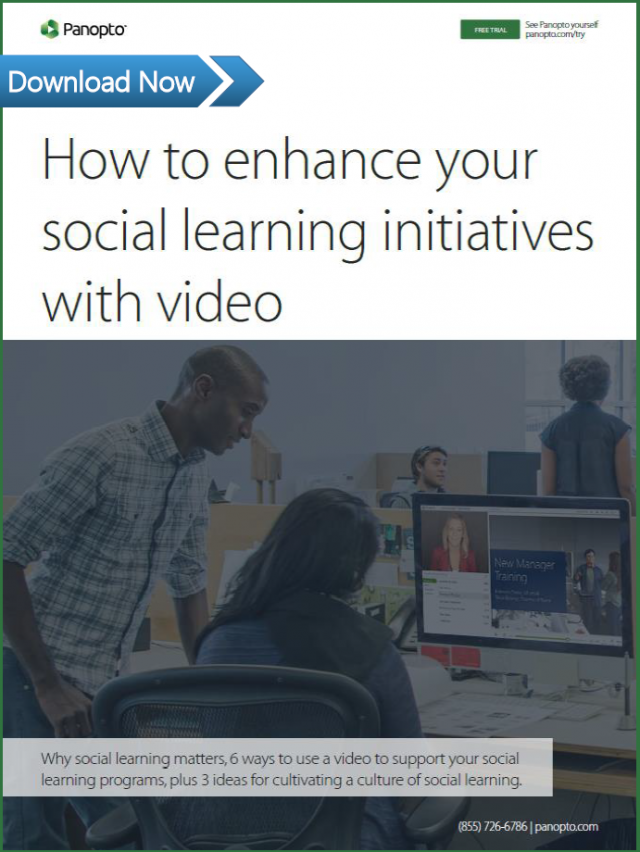- Collaboration
6 Ideas For Supercharging Social Learning

In recent years, the ease and accessibility of video has recast what’s possible when it comes to organizational social learning programs.
Today, along with text-based wikis and social tools, employees can tap the video cameras already built into their smartphones and laptops and quickly demonstrate a skill, capture a recommendation, or present a new concept.
An enterprise video platform provides the technology foundation for a social learning program. Once the EVP is deployed, the next step is to build a set of social learning initiatives that give employees guidance on the types of videos that will be helpful for their colleagues.
Below are six such initiatives that help employees get to know each other, identify subject matter experts, and share their expertise so that coworkers can observe, iterate, and improve.
1. Introduce employees to one another
Employee introduction videos are a great onboarding strategy that can help new hires feel like a part of the team. With a simple slide presentation and webcam video, employees can record a brief overview that can then be distributed throughout the department.
View an example “getting to know you” video below:
Of course, the value of the videos extends well beyond that of a digital name tag. Intro recordings help existing and new employees identify subject matter experts and understand who works on what. With a workforce that is increasingly distributed across multiple geographic locations, video intros help all your team members find out who they can go to when they have a question.
2. Demonstrate job-specific functions
In most organizations, formal L&D efforts can’t scale to teach the specifics of every job across the company. In the past, the best solution was in middle management. Effective managers could pass on the techniques and best practices they’d seen work before. As coaches, they could respond to individual team members’ needs and help them with a tip or a pointer to additional resources. Of course, truly great managers are hard to find — and hard to keep. And for larger organizations, that difficulty often translates into inconsistent performance between teams and employees.
A social learning program rooted in video helps teams share role-specific knowledge in a peer-to-peer manner without the time and cost associated with in-person, real-time interactions. For many knowledge workers, webcam and screen recording video can be enough to describe a wide variety of business functions. For technicians in a laboratory or building maintenance managers training new hires, video recorded on a smartphone can provide the same benefit.
3. Explain new product and process developments
Most organizations are constantly updating their products and processes. To ensure that everyone is working from the same page, teams dedicate substantial time and energy to continually documenting what’s new.
Watch an SME explain a technical process in the following video:
As scrum and agile philosophies continue to shorten product launch cycles, the “explainer video” can be a powerful social learning tool for documenting progress and sharing it with people throughout the company. Asking project leads to record a short explanation of each new product feature or process change will create an essential map for other teams to understand what’s changed and why. It also provides a useful reference guide for the team’s own new employees as they onboard and get up to speed.
As an added advantage, recording these videos often takes less time than cataloging the updates in emails, formal changelogs, and other documents.
How much could you save by
sharing knowledge through video?
Calculate Your Savings
4. Help people navigate workplace policies and procedures
In virtually every company, employees need to understand a set of workplace policies and processes in order to do their job. These seemingly little details can still steal hours of productivity, especially as the confused seek help from their colleagues. Every organization’s list of issues will be unique, but common policies include:
- Coding expenses for reimbursement
- Determining which project components fall under data retention policies
- Ensuring legal compliance for firm communications
- Problem reporting to engineering, IT, or HR
Organizations often try to provide answers to these ahead of time as formal employee training courses and documentation, but the breadth and specificity of potential questions make it almost impossible to eliminate blind spots. Through the use of short, specific, employee-generated videos, businesses can fill in the gaps and provide their workforce with “just in time” learning for workplace policies and procedures.
5. Record meetings — for review or preview
Love them or loathe them, meetings are how most organizations provide important updates and make decisions day to day. Yet too many businesses treat meetings as ephemeral. Employees unable to attend miss the valuable points of discussion and rationale for key decisions.
Here, businesses can learn from universities, who now commonly record classroom sessions for students to review as study aids. Following this model, businesses can easily use the webcams built into company laptops, or the video hardware installed in conference rooms, to document meetings and make them available for on-demand review.
Alternatively, many organizations are embracing a new meeting structure called the “flipped meeting” that uses video to make scheduled facetime more productive. By recording and sharing a video of their presentation ahead of time, meeting owners can focus the meeting on conversation, debate and decision making. Those pre-meeting materials then become a useful record of the project for current and future team members alike.
Recording meetings can also be a quick win when combined with one of the more established forms of social learning: the brown bag. Whenever employees feel that they have something worth sharing, why not record it? The benefits will extend well beyond those employees that had the luxury of attending the in-person session.
6. Preserving expertise at “Two Weeks Notice”
Social learning also protects against one of the biggest detriments to productivity: employee turnover. Just as video onboarding helps new employees get up-to-speed efficiently, video-based knowledge capture helps ensure that the individual expertise isn’t lost when career or life changes take an employee away from their position or company.
See how video can help keep a departing employee’s expertise inside your company:
Especially when the departure is unexpected, video can be an efficient way for outgoing employees to share what they know in full detail. And if the position is complex, the visual nature of video can help a replacement follow along. For companies that have not yet invested in social learning as a practice, recording a “two weeks notice” video may need to become a new part of the exit process. For companies that have a culture and infrastructure to support social learning throughout the course of employment, however, many find that the outgoing employee’s accumulated knowledge is already available — and often, already serving to help others across the firm.

Read More About Supporting Social Learning With Video
In our newest white paper, How To Enhance Your Social Learning Initiatives With Video, you’ll learn how your organization can embrace social learning, you’ll discover 6 ideas for getting started, and you’ll gain an understanding of how an enterprise video platform can provide the technology foundation to your social learning program.


